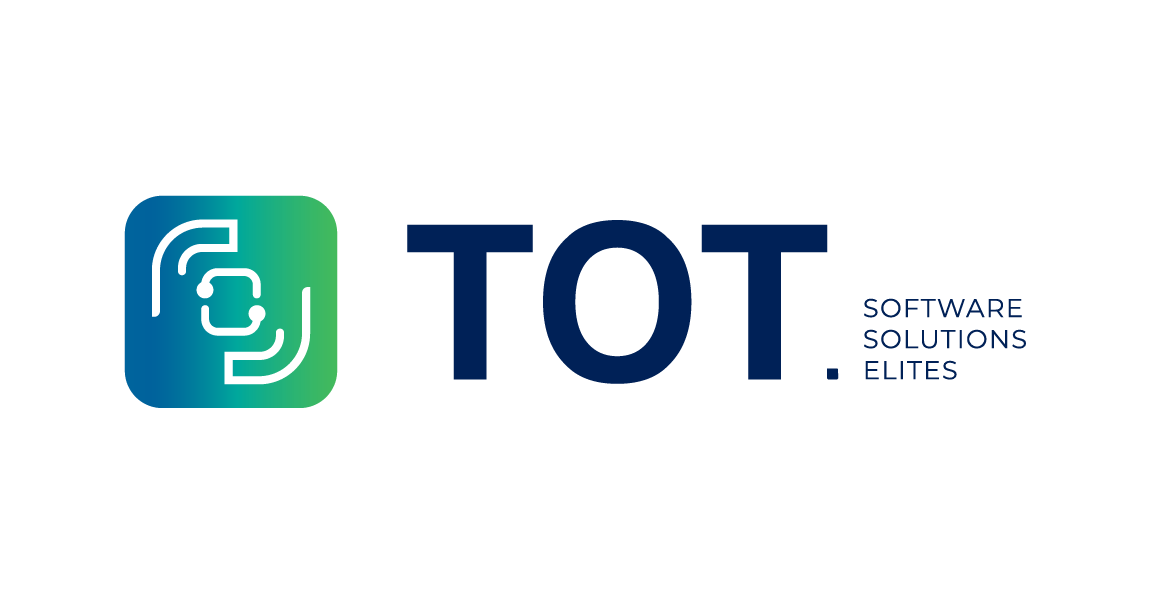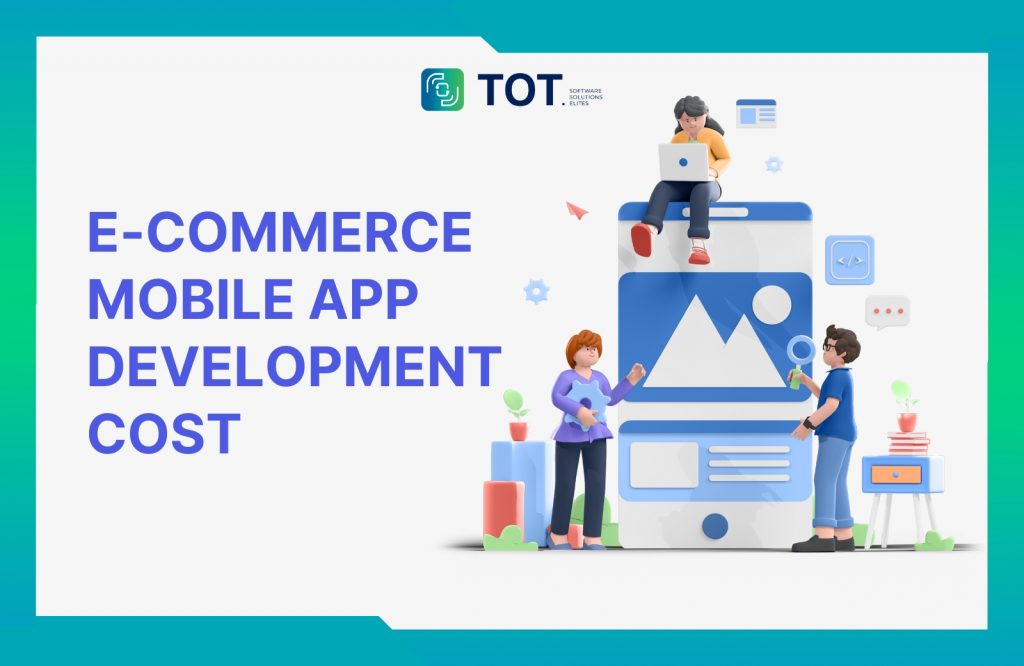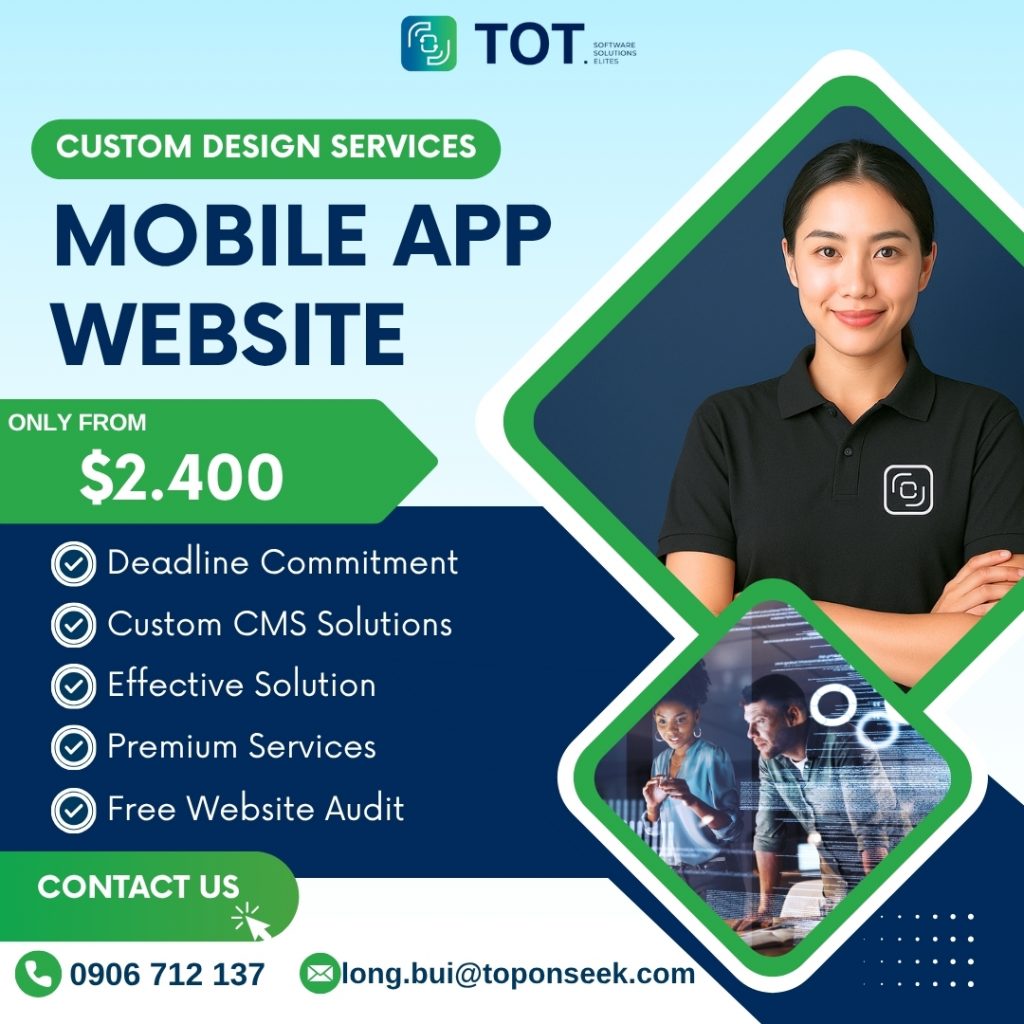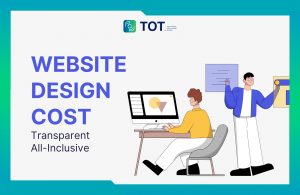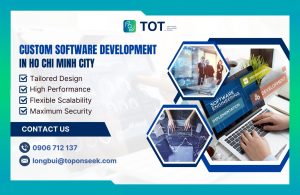E-commerce mobile app development cost is one of the biggest considerations for businesses planning to build a competitive online shopping experience. Understanding what drives the price from feature complexity to design quality, backend infrastructure, and long-term maintenance helps companies budget wisely and avoid hidden expenses. In this guide, TOT will break down the major cost factors, average pricing ranges, and practical strategies to reduce development spending while ensuring a high-performing, scalable e-commerce app.
>>> Read more:
- Top 12 Web Design Agencies in Vietnam – Trusted & Professional
- Top 10 IT Outsourcing Companies in Vietnam [Most Updated 2025]
- Top 15 Software Outsourcing Company in Vietnam
- Software Development Company in Vietnam – Top 10 Best Choices for 2025
- Top 10 Web Agency Offshore Companies for Global Businesses
Types of E-commerce Mobile Apps and Their Cost Implications
E-commerce apps come in various business models, each requiring different feature sets, architectures, and investment levels. Understanding the type of app you want to build helps estimate development scope, technical complexity, and long-term operating costs.
Single-brand ecommerce apps
These apps are designed for individual brands or retailers selling their own products—similar to Nike, Zara, or Sephora apps. They focus on direct-to-consumer (D2C) engagement, streamlined product discovery, loyalty programs, and personalized shopping experiences. Single-brand e-commerce apps are generally the least expensive, with typical development costs ranging from $20,000 to $80,000 or more, depending on features like push notifications, AI recommendations, or loyalty integrations. Costs remain moderate because the system only manages one seller and one inventory source.
Multi-vendor marketplace apps
Marketplace apps like Shopee, Lazada, or Etsy allow multiple vendors to sign up, list products, manage inventory, and process orders. They require advanced systems for seller onboarding, catalog management, vendor dashboards, multi-cart processing, and dispute handling. Multi-vendor apps are the most complex ecommerce model, often costing $70,000–$250,000+. Complexities arise from real-time inventory syncing, vendor analytics, revenue models (commission and subscription), multi-warehouse shipping, and advanced search algorithms.
B2B ecommerce platforms
B2B ecommerce apps serve wholesalers, manufacturers, and enterprise buyers. They support bulk ordering, tiered pricing, contract management, quotation workflows, credit terms, and integration with ERP systems such as SAP or Oracle. Because they require custom pricing rules, deep API integrations, and enterprise-grade security, B2B e-commerce app development typically ranges from $50,000 to $200,000 or more. Special features—such as multi-branch procurement or role-based access—significantly increase complexity.
Subscription-based or niche ecommerce apps
Examples include meal-kit apps, curated monthly boxes, digital products, and niche specialty stores such as eco-products, handmade goods, etc. They rely heavily on recurring billing, recommendation engines, and community-driven UX. Subscription-based apps usually cost $30,000–$120,000+, depending on the complexity of billing automation, content delivery, and personalization algorithms. Apps with AR-powered try-on features or AI personalization may be more expensive.
Through a radical modernization of the user interface (UI/UX overhaul) and platform technology enhancement, TOT transformed the app into a powerful customer retention tool. This solution was grounded in detailed user research and ensures consistency with the Mazda brand identity.
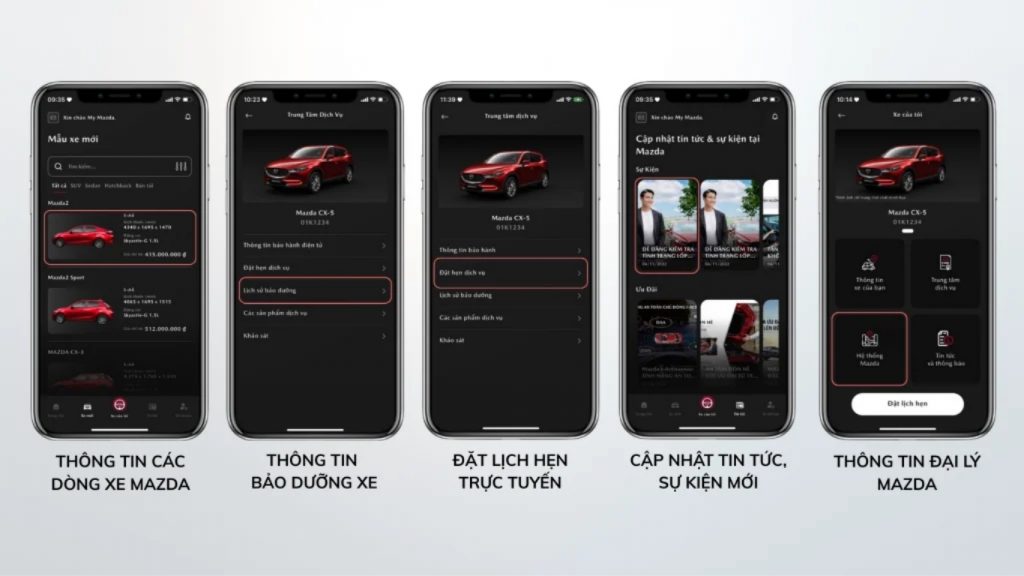
>>> Read more:
- Custom Software Development in Ho Chi Minh City – Professional, Multi-Platform Solutions
- Custom Software Development in Hanoi – Professional and Affordable Solutions
- Restaurant Website Design — Professional, Modern 2025
Key Factors That Influence E-Commerce App Development Cost
The cost of developing an e-commerce mobile app can vary significantly depending on the project’s complexity, technical requirements, and long-term scalability needs. Understanding the main cost drivers helps businesses plan budgets effectively and avoid unexpected expenses during and after development. Below are the key factors that have the biggest impact on your e-commerce app development cost.
Feature set & complexity
The more advanced your app is, the higher the cost. Core features include:
- User account & onboarding
- Product catalog & search
- Cart & checkout
- Payment gateway (Stripe, PayPal, MoMo, ZaloPay, etc.)
- Order tracking & notifications
Advanced features increase costs significantly:
- AI product recommendations
- Augmented reality try-on
- Real-time chat or chatbot
- Multi-vendor dashboards
- Complex promo engines
- Multi-currency & multi-language support
The more custom logic, personalization, and third-party services an app requires, the more development time and budget it will demand.
Platform choice
Your chosen development approach strongly influences cost.
- Native apps (built separately for iOS and Android) provide the best performance and allow deeper access to device features—but cost more since two codebases are developed.
- Cross-platform frameworks, such as Flutter or React Native, reduce costs by enabling a single codebase for both platforms while still delivering near-native performance.
- Hybrid apps are generally more cost-effective but may offer lower performance for feature-rich e-commerce platforms.
Choosing the right platform mix depends on your target audience, budget, and long-term maintenance strategy.
UI/UX design quality
High-quality UI/UX design plays a crucial role in user engagement and conversion rates, and it also impacts the overall cost. Custom design elements, interactive animations, micro-interactions, tailored product flows, and intuitive navigation require more design hours than template-based layouts. For competitive markets like e-commerce, investing in a polished, conversion-optimized design can significantly increase ROI—even if it adds upfront cost.
Backend infrastructure & integrations
A robust backend is crucial for managing product data, user accounts, payments, inventory, and order processing.
Costs increase when the app requires:
- Complex database structures
- Integration with ERP, CRM, POS, logistics, 3PL, or warehouse management systems
- Multiple payment gateways
- Advanced analytics tools or marketing automation platforms
- Custom APIs or microservices architecture
The more integrations and backend logic needed, the higher the development complexity and overall budget.
Development team location & hourly rates
Where your development team is located can dramatically impact total costs.
- Developers in the U.S., Canada, Western Europe, or Australia have the highest hourly rates.
- Teams in Eastern Europe, Vietnam, India, and Southeast Asia offer skilled development at more competitive rates.
Hourly rates usually range as follows:
- $80–$150/hour (U.S./Europe)
- $30–$60/hour (Eastern Europe)
- $20–$40/hour (Vietnam & Asia-Pacific)
These differences can affect the final project cost by tens of thousands of dollars.
>>> Read more:
- Create a Free Online Store Website: A Quick, Detailed, and Effective Guide
- Custom Website Design Services in Ho Chi Minh City
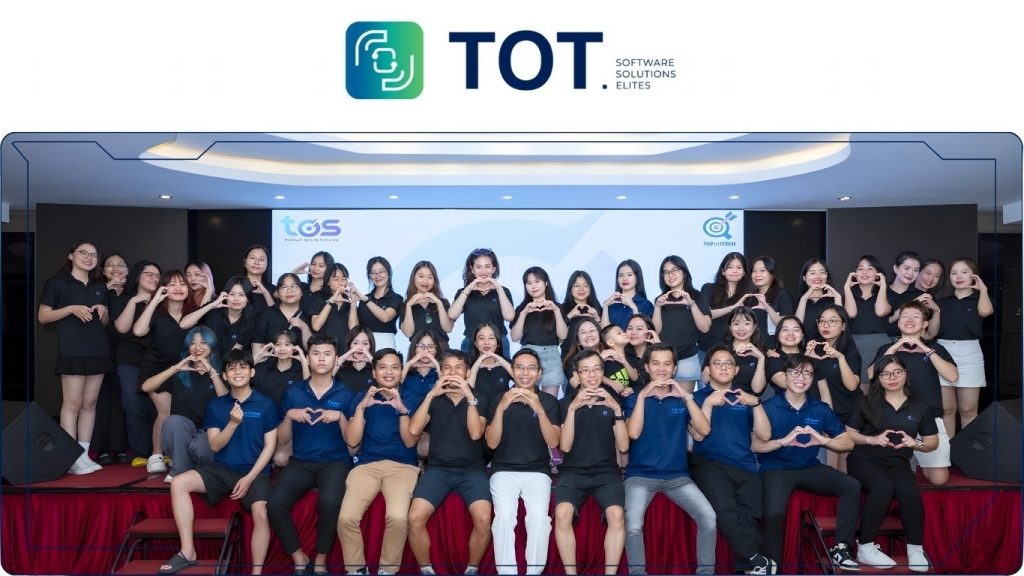
Maintenance, updates, and hidden post-launch costs
Development costs do not end at launch. Ongoing maintenance is essential to ensure security, performance, and a seamless shopping experience. These costs typically include:
- Bug fixes and performance optimizations
- API updates and SDK upgrades
- New OS version compatibility
- Server hosting, monitoring, and cloud services
- Adding new features based on user feedback
- Security patches and data protection updates
Maintenance typically accounts for 15–25% of the annual development cost and should be included in long-term budgeting.
Average E-commerce Mobile App Development Cost Breakdown
Understanding how costs are distributed across different stages and complexity levels helps businesses plan budgets more accurately. E-commerce app development costs vary widely depending on features, platforms, team structure, and long-term goals. Below is a detailed breakdown to help you estimate your investment more effectively.
Cost ranges by complexity
E-commerce apps fall into three general categories, each with different development requirements:
- Basic Apps ($20,000 – $40,000): These include essential features such as product listings, basic cart, user login, and simple payment integration. Suitable for small businesses or startups validating an idea.
- Mid-Level Apps ($40,000 – $90,000): Include advanced search, multi-vendor options, personalized recommendations, analytics dashboards, push notifications, and multiple payment gateways.
- Enterprise-Level Apps ($90,000 – $250,000+): Including complex backend systems, AR try-on, AI personalization, loyalty programs, ERP/CRM integrations, real-time inventory sync, and international support. Built for large-scale operations.
Cost by development stage
Each phase contributes differently to the overall budget:
- Planning & Requirement Analysis (5–10%):
Market research, user flows, tech stack planning, and roadmap development. - UI/UX Design (10–20%): Wireframes, prototypes, UX writing, design system, and interactive mockups.
- Development (40–55%): Frontend development, backend setup, integrations, and feature implementation.
- Quality Assurance (15–25%): Manual and automated testing, performance tests, security audits, bug fixes.
- Deployment & Launch (5–10%): App Store/Play Store submission, server setup, and launch optimization.
Hourly rate model & how to calculate your project estimate
The hourly rate model is one of the most widely used pricing structures for estimating e-commerce mobile app development costs. Instead of paying a fixed price, businesses pay based on the number of hours required to complete each development task. This model is highly flexible, enabling teams to adjust scope, features, and timelines without requiring renegotiation of an entire contract.
Hourly rates vary significantly depending on region, expertise, and technology stack, as confirmed by multiple industry sources:
- US & Canada: $100 – $180/hour
- Western Europe: $60 – $120/hour
- Eastern Europe: $35 – $60/hour
- India & Southeast Asia: $20 – $40/hour
To calculate your project budget using the hourly model, use this simple formula:
Total Cost = (Estimated Hours per Development Stage) × (Hourly Rate)
Sample case studies or benchmark cost examples
Real-world benchmarks help businesses better understand how e-commerce app budgets vary in relation to complexity, features, and technology choices. Below are sample cost scenarios based on data from reputable industry sources, including Appinventiv, Mobiloud, Perimattic, and Creole Studios.
Enterprise-Grade Ecommerce App
Peugeot Vietnam partnered with TOT to upgrade the My Peugeot App – a multifunctional platform that supports customers in exploring car models, booking services, managing vehicle information, and receiving real-time updates. The goal was to modernize the user experience and address existing UX/UI and performance issues in the old version, within 4 months.
Challenges
- UI lacked consistency with Peugeot’s brand identity
- Poor user experience led to lower app store ratings
- Missing key functionalities, such as online service booking
- Outdated infrastructure requiring synchronization with Thaco Auto’s systems
TOT delivered a full-cycle redesign and development, including:
- UX research to identify pain points
- Modern UI/UX redesign aligned with Peugeot standards
- Development of a new technical architecture integrating with DDMS & Peugeot systems
- Building “Peugeot Workspace” for real-time data sync
- End-to-end mobile development using React Native, .NET Core, Next.js
The new My Peugeot App offers:
- A modern, intuitive, and brand-consistent interface
- Online test-drive and maintenance booking
- Detailed vehicle information & model comparison
- Showroom locator and real-time promotions
- Improved performance, usability, and customer satisfaction
The app now serves as a core digital touchpoint, strengthening customer engagement and supporting Peugeot Vietnam’s digital transformation.
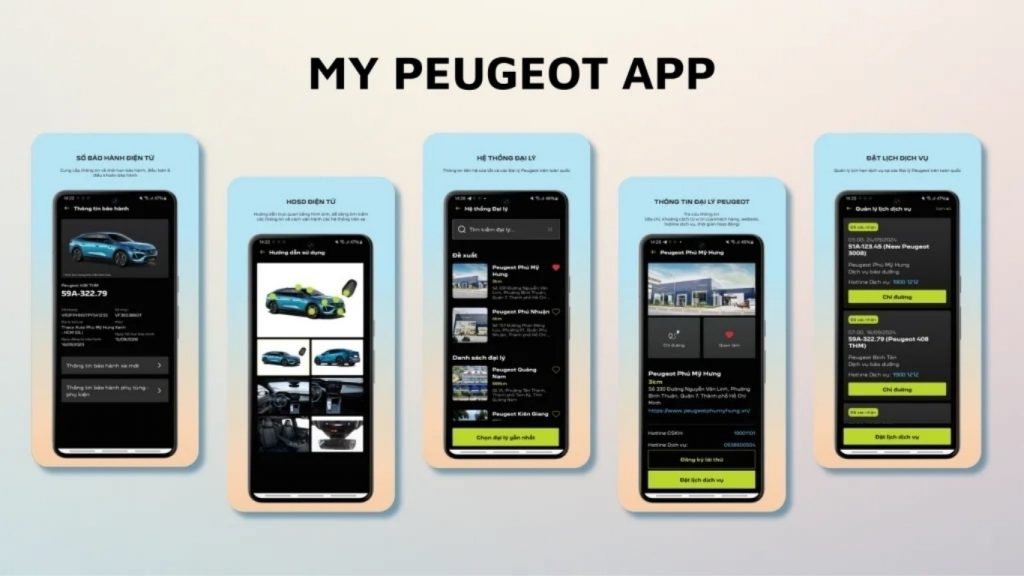
How to Reduce E-Commerce App Development Costs
Reducing the development cost of an e-commerce app requires a strategic balance of choices, technology, and long-term planning. Many companies overspend not because the product is inherently expensive, but due to unclear requirements, rework, and inefficient development practices. Below are the most effective cost-saving approaches adopted by scaling startups and enterprise teams alike.
Start lean with an MVP (Minimum Viable Product)
Building an MVP is one of the most reliable ways to reduce upfront costs. Instead of developing a fully featured app from the start, businesses focus on launching only the core features: browsing, cart, checkout, and essential admin functionalities. According to AppInventiv, companies that start with an MVP reduce initial development expenses by 30–50% while validating product-market fit earlier.
An MVP also minimizes risk because you invest only in features your users actually want, real-world usage data, rather than assumptions, and guides future enhancements.
Choose the right tech stack
The selection of the tech stack has a strong influence on development time and cost. Cross-platform frameworks such as React Native and Flutter enable teams to build both iOS and Android apps using a single codebase. This reduces development hours by 40–60% compared to creating two separate native apps, based on cost analyses published by Saigon Technology and Perimattic.
Additionally, modern frameworks have prebuilt components, active communities, and extensive libraries, which make development faster, easier, and more cost-effective.
Use pre-built modules or templates wisely
Pre-built modules—such as payment gateways, login authentication, admin dashboards, push notification services, or analytics packages—help reduce the amount of custom coding required. According to MobiLoud, integrating existing components can save hundreds of development hours, especially for features that do not require full customization.
However, these components should be used strategically. Over-reliance on templates may limit scalability or lead to increased technical debt later. The best approach is balancing reusable modules for common functions with custom development for business-critical or brand-centric features.
Partner with experienced development vendors
Working with a skilled development partner may seem costly upfront, but it saves significant money in the long term. Experienced vendors offer:
- Accurate cost estimation
- Streamlined workflows
- High-quality code requiring fewer revisions
- Better planning for scalability and integrations
Research from Clutch shows that projects handled by top-rated teams have 25–35% fewer post-launch issues, resulting in reduced maintenance and re-engineering costs. Choosing a vendor with e-commerce expertise also ensures familiarity with key integrations such as ERP, inventory, logistics, and payments.
Focus on essential UX first, add premium features later
Many e-commerce apps overspend by implementing advanced features too early, such as AR try-on, AI recommendations, or complex loyalty systems. While these features add value, they can significantly increase the initial cost.
Instead, start with:
- Clean navigation
- Clear product information
- Smooth checkout flow
- Secure payment integrations
Once the app gains traction, you can introduce premium features gradually in response to user demand. This iterative model aligns spending with growth, ensuring ROI at each stage.
Plan for scalability to avoid re-engineering costs
Lack of scalability planning is one of the most common and expensive mistakes in e-commerce app development. Rebuilding backend systems or databases later can cost two to three times or more than implementing a scalable architecture from the start.
To minimize long-term costs, ensure:
- A modular codebase that allows feature expansion
- Cloud-based infrastructure for flexible scaling
- APIs that support future integrations
Database architecture designed for high-traffic growth
Planning for scalability early prevents costly re-engineering efforts and supports seamless expansion as your user base grows.

Selecting the Right Development Partner
Choosing the best development partner is one of the most crucial decisions in any e-commerce app project. The right team ensures smooth execution, cost efficiency, and long-term scalability, while the wrong choice can lead to delays, overspending, and technical limitations. Below are key factors to consider when evaluating potential partners.
What to look for in an e-commerce app development company
A reliable development partner should have proven experience building e-commerce platforms, with a strong portfolio that demonstrates high-quality UI/UX, scalability, and performance. Look for companies that understand e-commerce fundamentals such as checkout optimization, security, inventory sync, multi-vendor architecture, and payment integrations. Client reviews, case studies, and third-party ratings (e.g., Clutch, GoodFirms) help validate credibility and establish assets. Certifications, long-term client relationships, and transparent pricing structures are also strong indicators of reliability.
Team composition & expertise required
A complete e-commerce development team typically includes:
- Business analyst — translates requirements into actionable features
- UI/UX designer — ensures seamless shopping experience
- Front-end developer — builds the customer-facing interface
- Back-end developer — handles server logic, databases, APIs, and integrations
- Mobile developer(s) — iOS, Android, or cross-platform
- QA engineer — tests performance, security, and usability
- Project manager — coordinates communication and timelines
The combined expertise ensures your app is not only functional but secure, scalable, and conversion-focused.
Development process: Agile vs Waterfall
Selecting the right development methodology directly affects timelines, flexibility, and overall project success. Agile focuses on iterative development, frequent testing, and continuous feedback. This makes it ideal for e-commerce apps, where requirements evolve quickly and user needs may shift. Agile allows teams to adjust priorities sprint by sprint, reducing risk and improving product-market fit.
In contrast, the Waterfall model follows a strict, linear sequence—requirements → design → development → testing → launch. While predictable and easy to manage, it lacks flexibility. Any change requested after development begins can be costly and time-consuming. Waterfall works best for projects with a fixed scope and clear requirements from the start. For most modern e-commerce applications, Agile delivers superior adaptability, speed, and quality.

Offshore vs onshore teams — advantages and disadvantages
Offshore teams are software development teams located in a different country—often in regions with lower labor costs such as Southeast Asia, Eastern Europe, or India. Companies choose offshore development to access highly skilled talent at a more competitive price point. Offshore partnerships typically rely on digital communication and remote collaboration tools, making project management discipline essential.
Advantages
- Significantly lower development costs due to reduced labor rates.
- Access to a larger global talent pool, especially for specialized skills.
- Flexible scaling enables companies to expand or reduce their team quickly.
- Round-the-clock development when time zones are leveraged effectively.
Disadvantages
- Time zone differences may slow communication if not managed properly.
- Potential language and cultural barriers impacting clarity and collaboration.
- Requires stricter project management to maintain alignment and quality.
- Legal and compliance considerations, especially for data-sensitive products.
Onshore teams, on the other hand, operate within the same country or geographic region as the client. This proximity enables face-to-face collaboration, real-time communication, and easier alignment with the business context. Onshore development is often chosen by businesses that prioritize tighter control, faster communication cycles, and compliance with local standards or regulations.
Advantages
- Real-time communication with minimal language or cultural gaps.
- Easier alignment on requirements, business logic, and workflows.
- Greater legal clarity, especially around contracts, data protection, and IP rights.
- Higher trust and accountability due to physical proximity.
Disadvantages
- Higher development costs, often 2–3x more than offshore teams.
- Limited talent pool, especially in smaller markets.
- Less flexibility in scaling, as local hiring takes more time and budget.
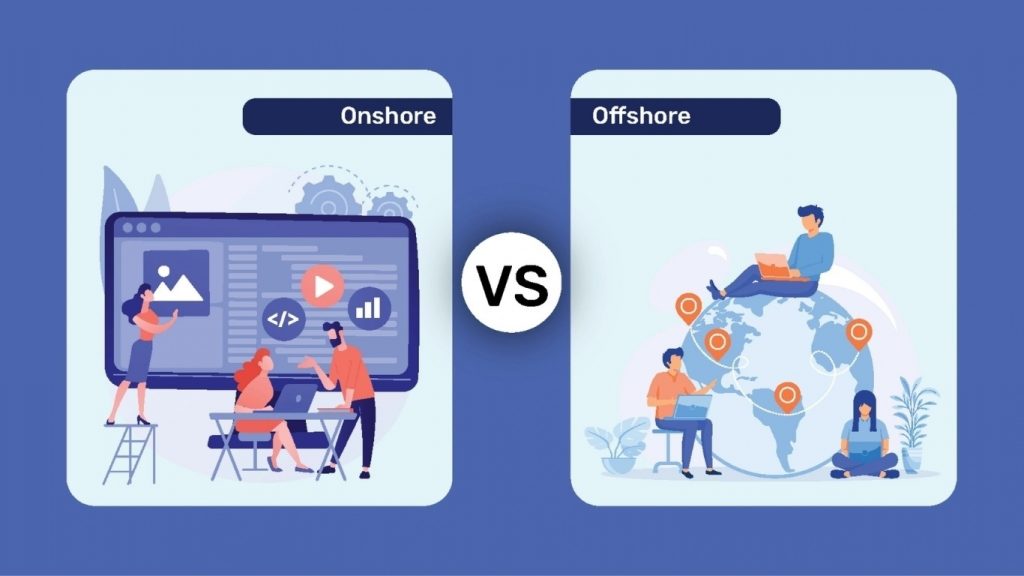
How to maintain transparency and cost control
Maintaining transparency throughout the development cycle is essential for staying on budget and avoiding unexpected delays. Begin by requesting a detailed proposal that outlines scope, features, estimated hours, and milestone-based payment terms. Utilize collaborative tools like Jira, ClickUp, or Notion to track progress, review completed tasks, and manage change requests in real time.
Clear communication rhythms, such as weekly reports, sprint reviews, and scheduled check-ins, help maintain alignment between your team and the development partner. It’s also essential to define a change management process to evaluate new features without derailing the budget. Finally, ensure your partner outlines upfront costs, ongoing maintenance fees, and any potential hidden expenses, to ensure complete cost transparency from start to finish.
E-commerce App Development Cost at TopOnTech
The cost of mobile app design and development can vary significantly depending on the app’s complexity, required features, and industry-specific demands.
Cost by App Complexity
1. Simple Apps
These include essential features such as login, basic content display, and simple navigation, with no API connections or custom backend. Estimated cost: $1,600 – $3,200 (40–80 million VND). Timeline: 1–2 weeks.
2. Mid-Level Apps
These apps integrate features like online payments, push notifications, and customized UI/UX interfaces. Estimated cost: $3,200 – $8,000 (80–200 million VND). Timeline: About 1 month.
3. Complex Apps
Designed for industries requiring high security, advanced data processing, or multiple third-party system integrations. Estimated cost: $8,000 – $20,000+ (200–500 million VND). Timeline: 3–6 months.
Cost Variation by Industry
The cost of mobile app development also depends heavily on the industry. Each sector demands tailored features, performance standards, and design complexity.
| Industry | Estimated Cost | Key Features |
| E-commerce | 3.790 – 11.380 USD | Cart, payment system, product & order management |
| Food & Beverage | 2.280 – 7.590 USD | Digital menu, reservations, reviews, and delivery integration |
| Education | 3.030 – 9.480 USD | Course management, video lessons, student interaction |
| Logistics | 4.550 – 15.170 USD | Shipment tracking, driver management, and GPS integration |
| Beauty & Spa | 1.900 – 5.690 USD | Booking system, service reviews, and staff scheduling |
Ongoing App Maintenance Costs
Once the app is launched, ongoing updates, security patches, and feature improvements are necessary to ensure performance and user satisfaction.
- Annual maintenance cost: Typically 15–20% of the original development cost.
- Monthly maintenance fees: Range from $250 – $500, depending on complexity and update frequency.
- App store publishing fees:
- Google Play Developer Account: $25 one-time fee
- Apple Developer Program: $99 annually
Frequently Asked Questions (FAQs)
How much does mobile app development cost?
Mobile app development typically ranges from $10,000 to $200,000 or more, depending on features, platform, design complexity, and the development team’s location. Simple MVPs cost less, while full-scale e-commerce or marketplace apps fall on the higher end.
How to create mobile apps that make $3,000 a day?
Apps generating $3,000/day typically rely on strong monetization models—such as in-app purchases, subscriptions, or e-commerce sales, and scalable marketing. High-quality UX, retention features, and consistent updates play a major role in building daily revenue.
How much is an app with 10,000 users worth?
An app’s valuation depends on its revenue, retention, active user base, and growth potential. Apps with 10,000 engaged users may be valued anywhere from $20,000 to $500,000 or more, depending on monetization and user activity metrics.
How much does it cost to develop an e-commerce platform?
A basic e-commerce app typically costs between $10,000 and $40,000, while complex multi-vendor or enterprise platforms can range from $70,000 to $250,000 or more. Factors influencing cost include features, integrations, platform choice, and long-term maintenance needs.
Understanding e-commerce mobile app development cost is essential for businesses planning to enter or expand in the digital marketplace. From feature complexity and platform choice to UI/UX design, backend integrations, and ongoing maintenance, each factor plays a critical role in shaping the overall budget. By planning strategically, starting with an MVP, selecting the right tech stack, and partnering with an experienced development team, businesses can optimize investment while ensuring long-term scalability and performance.
Suppose you’re seeking a trusted partner to develop a high-quality, cost-effective e-commerce mobile app. TOT delivers end-to-end design, development, and optimization solutions tailored to your business goals.
TOT is a pioneer in the digital transformation journey. We deliver website design, mobile app development, and custom software solutions with flexible services tailored to each business’s exact needs.
Inspired by the philosophy of “Technology for People,” TOT empowers businesses to operate more efficiently, elevate customer experiences, and build a lasting brand impression.
TopOnTech (TOT) Contact Information:
🌐 Website: https://topon.tech/en/
📞 Hotline/WhatsApp/Zalo: (+84) 906 712 137
✉️ Email: long.bui@toponseek.com
🏢 Address: 31 Hoang Dieu Street, Ward 12, District 4, Ho Chi Minh City, Vietnam
